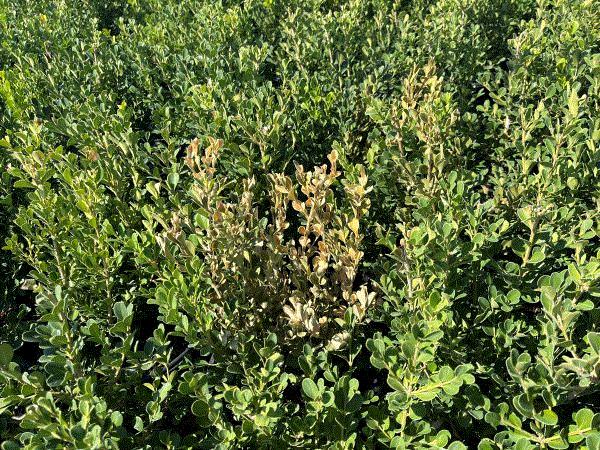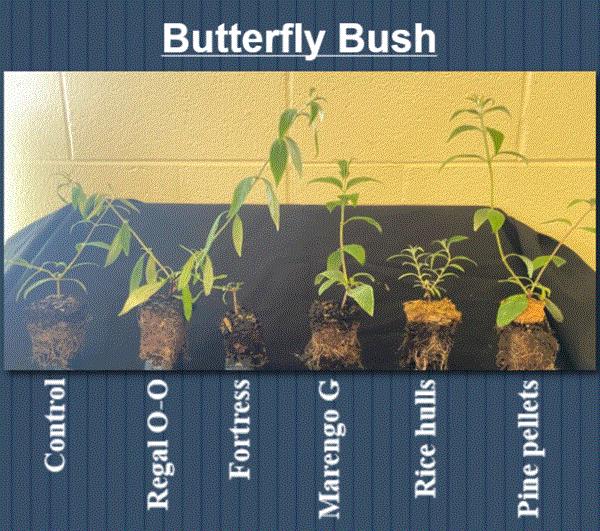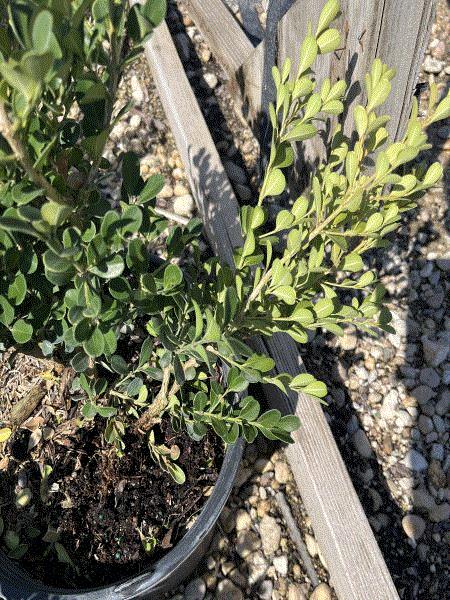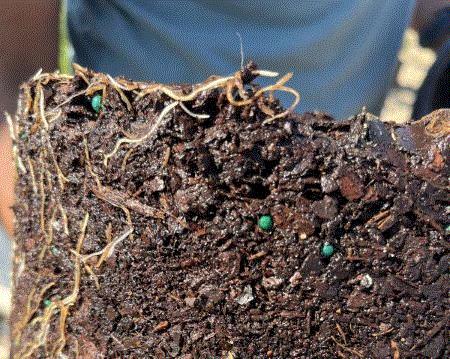What the ... ?
I want to visit an issue I observed in Texas in mid-October. The same issue appeared in several nurseries I'd visited.
In most cases, I saw several dead, brown boxwoods scattered in an otherwise good-looking block. The leaves didn’t fall off, but the plants certainly didn’t look alive. There were more that were in the process of turning color, from a little chlorotic to straw-like.
What could this be?


Preemergent Herbicide + Mulch in Propagation
I chatted about weed management in propagation in the last issue of this newsletter. While I was doing research on the topic, I came across an article by Isha Poudel and Anthony Witcher at Tennessee State University on the use of preemergent herbicide and mulch in cutting propagation. The article was published in the March issue of the scientific journal Horticulturae (go HERE for a copy of the article).
The premise of Isha and Anthony’s research is pretty simple: You can control weeds with mulch and perhaps some preemergent herbicide (which could potentially be used based on previous research, although none is currently labeled for propagation) in cutting propagation, but which ones are more effective and safer?
To answer that question, Isha and Anthony conducted a series of experiments to look at the efficacy of preemergent herbicides (Gallery/isoxaben, Regal O-O/oxyfluorfen + oxadiazon; Fortress/isoxaben + dithiopyr; and Marengo G/indaziflam) and mulch (rice hulls and pine pallets) in controlling weeds in propagation of Nanho Blue butterfly bush and Catawba crape myrtle cuttings.
Rooting of cuttings in media treated with herbicides or covered with mulch were evaluated in a propagation trial when roots seemed to have grown in. Shoot growth and leaf greenness of these cuttings two or three months after transplant were also evaluated in a transplant trial. In another trial, the efficacy of these herbicide and mulch treatments against the germination and growth of hairy bittercress, large crabgrass, creeping woodsorrel and mulberry weed was evaluated.
I’m not going into the details of the experimental design here. Go HERE to read the article if you’re interested in the methodologies. I’ll summarize some of the major findings of Isha and Anthony’s research.
Butterfly bush cuttings treated with Gallery and Fortress had lower average rooting percentages (20% and 36%, respectively) compared to the untreated cuttings (84%) and those treated with other herbicides and mulch (72% to 88%).
Rooting percentage and root dry weight of crape myrtle cuttings weren’t affected by any of the treatments (all above 80%), but Gallery significantly reduced total root length and root surface area compared to the untreated control.
The shoot height and shoot width of butterfly bush and crape myrtle cuttings were similar among all treatments two or three months after transplant. The results suggest to me that isoxaben—although it’s one of the most commonly used preemergent herbicides in container plant production—may not be the most suitable option for propagation mainly because of its impact on rooting and growth of sensitive species, such as butterfly bush. (I mean, really, butterfly bushes can die if I stare at them just a little too hard. And Gallery and Fortress aren’t labeled for use on butterfly bush anyway, for reasons demonstrated in this study.)

The effects of selected preemergent herbicides and organic mulch on rooting of butterfly bush cuttings. Cuttings treated with Gallery were not good looking enough for the group photo. (Photo credit: Isha Poudel and Anthony Witcher, Tennessee State University.)
Although Gallery can be problematic in propagation of sensitive species, it’s quite effective against broadleaf weeds in Isha and Anthony’s efficacy trial. Pots treated with Gallery were free or almost free of woodsorrel, bittercress and mulberry weed four weeks after weed sowing. (Woodsorrel and mulberry weed seeds were sown 20 days after herbicide and mulch application, and bittercress and crabgrass seeds 25 days after application.) Pots treated with other herbicides and mulch also had significantly lower weed seed germination than the untreated pots (except for Marengo G for crabgrass) at four weeds after weed seed sowing. Rice hulls were slightly (but not significantly) more effective than pine pellets in reducing weed germination and growth.
I think this research is pretty important because it demonstrates that, although no preemergent herbicides are registered for use in propagation, there are several options that are worth further development. Regal O-O stands out as an option that’s both safe and highly effective for sensitive (such as butterfly bush) and not-so-sensitive species (such as crape myrtle) in propagation and transplant phases.

Speaking of Organic Mulch ...
Rice hulls are definitely gaining popularity in greenhouses and nurseries. Many operations I visited last year have piles and bags of them. There’s a lot to like about rice hulls, especially for greenhouse production where there’s essentially no preemergent herbicide use. Yeah, you have some available for use when the greenhouses are empty, such as Marengo (indaziflam) and SureGuard (flumioxazin), but folks are always very careful about using them because of their long residual activity in beds. (Go HERE for an article from Joe Neal of North Carolina State University on herbicide use in greenhouses.) Mulch, such as pine pellets and rice hulls studied by Isha and Anthony, provide safe ways to prevent weed germination in greenhouse production.
Rice hulls and pine pallets, as well as wood chips and other naturally derived materials used for weed management are considered organic mulches. How much do you know about organic mulch? By organic, I don’t mean mulch that’re OMRI-listed or certified organic—these are simply derived from natural materials.

Oragnic mulch can be used as an effective weed management tool in greenhouses. (Photo credit: Debalina Saha, Michigan State University.)
If you’re not familiar or want to learn more about organic mulch for use in greenhouses, go HERE for an e-GRO Alert article from Supti Saha Mou and Debalina Saha of Michigan State University. Supti and Debalina introduce the different types of organic mulch, and the pros and cons of organic mulch.
Supti and Debalina also reported on one of Debalina’s studies where she found that the particle size of organic mulch makes lots of difference in weed control efficacy. Mulch with a finer particle size retain more moisture on the surface and therefore allow weed seeds that land on the mulch surface a better environment for germination. Mulch with larger particle sizes leave a drier surface with less weed problems. This lesson is applicable to both indoor and outdoor production.
Regardless of the type of organic mulch you use, sanitation is still critical. If you can clean up all of the weeds within the beds or growing areas, then there isn’t a source of seeds and you can use whichever type of mulch you like (or not).
This is a good read for learning more about organic mulch for weed management.

Monarchs as a Protected Species?
I (and perhaps y’all, too) have heard for a while that the U.S. Fish & Wildlife Service, which administers the Endangered Species Act, is considering listing the Monarch butterfly as a protected species. The Fish & Wildlife Service has finally taken one step forward in making this possible by seeking public input in its proposal. Go HERE to read the agency’s press release.
Go HERE for a brief report on this news from our own Ellen Wells in her buZZ! newsletter. You can submit your comment to the Monarch proposal by going HERE. The 90-day comment period ends on March 12, 2025.
Grants Awarded for Monarch and Pollinator Conservation
The National Fish and Wildlife Foundation announced in late November that its Monarch Butterfly and Pollinators Conservation Fund has provided $5.2 million in grants to 17 projects to conserve Monarch butterflies and other insect pollinators in 24 states. The organization is also able to leverage an additional $5 million in matching contribution for total support of $10.2 million.
Go HERE for a list of projects funded. These projects will increase the quality and quantity of habitats (more than 26,000 acres) for various pollinators, such as the Monarch butterfly and rusty patch bumble bee. They'll also collect and propagate milkweed seeds and host more than 190 educational workshops and meetings.

Buckeye butterflies on gaillardias. (Photo credit: Joyful Butterfly.)
Our industry certainly benefits when the conservation of the Monarch butterfly and other pollinators maintain a high profile in public opinion. After all, the pollinators need plants—plants that we grow—to thrive. I’ve seen several small businesses grow with the growing interest in pollinator conservation, such as Joyful Butterfly in the tiny community of Blackstock, South Carolina.
Owner Kelly Ballard has grown the business from a hobby to one that sends carefully and consciously grown plants throughout the country. Kelly and I worked on selecting pest management tools and approaches that eliminate harmful effects when milkweeds and other food plants are planted in the gardens. I'm absolutely proud of how Kelly has diligently grown her business!

Answer to “What the … ?”
If your answer to this week’s “What the … ?” mystery is root rot, crown rot or wilt, then you get a point. You get a bonus point if you can answer the question, “Which root rot disease?”
Boxwood can get all kinds of root rot diseases caused by Phytophthora, Pythium, Fusarium, Armillaria, Rhizoctonia … you name it! When you search online for information on crown and root rot diseases of boxwood, you’ll likely get many articles on Phytophthora (such as this article), but know that Phytophthora isn’t the only possibility. It’s best to send in samples for proper diagnosis.
The growers I visited sent in samples and were told that it was Fusarium. When I looked at the plants on site, many of the dying or dead plants had poor root systems. When the root balls were pulled out of their pots, I saw a mix of apparently healthy and mushy brown roots. I pulled at the roots and the epidermis and cortex simply sloughed off (giving the “rat tail” appearance), telling me that Pythium was also involved.

Hardly any live roots left in this one.
So is it possible to find multiple root rot diseases in a single pot? Sure! In fact, it’s possible that one pathogen (such as Fusarium) damages or weakens a plant enough that the opportunity presents itself to another more optimistic pathogen (such as Pythium). Jen Polanz (via last week’s Inside Grower) also noted a similar relationship between Fusarium and Pythium in spinach.
Did you notice that root rot seemed to be more severe on one side of the root ball? High heat on the sunward side of a black pot and uneven distribution of fertilizer certainly didn’t help with disease prevention. A stressful environment made things worse in this case.

A boxwood root ball impacted by Pythium. Look closely at the center of the blue background (a shirt actually) and you may see the "rat tail" symptom of a root caused by sloughing off of the Pythium-infected root epidermis.
Again, this case emphasizes the importance of proper growing practices and accurate disease diagnosis. If you think it’s Phytophthora that’s causing your problem—but in fact it’s a combination of Fusarium and Pythium—you’ve likely wasted your money on the fungicides you just sprayed.
Let’s make it a New Year's Resolution—I will have all of my pest and disease problems properly and accurately diagnosed in 2025.



Happy holidays! See y'all in 2025!

JC Chong
Technical Development Manager at SePRO
Adjunct Professor at Clemson University
This e-mail received by 27,847 subscribers like you!
If you're interested in advertising on PestTalks contact Kim Brown ASAP!